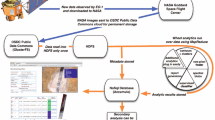Abstract
With the increasing number of objects in earth orbits, space situational awareness (SSA) becomes critical to space safety. As an economical option, ground-based telescopes can be deployed around the world and continuously provide imaginary information of space objects. However, they also raise unique challenges regarding big, noisy, and streaming data processing. In this paper, we present the SPIN system to address these challenges. The core algorithms process image sequences generated by ground-based telescopes and conduct: (1) image quality classification for data cleaning, (2) stream-based key-object identification and anomaly detection, and (3) efficient query processing on large image sequence repositories. Our goal is to design or adopt algorithms that handle the domain-specific image streams most efficiently and effectively. We use a 17-inch telescope to collect a large real dataset for evaluating the core algorithms, which covers more than ten satellites in one month and contains about 16,400 images. The experimental results show that the developed algorithms are fast enough for stream-based real-time processing and also yield high-quality results for all the primary tasks.











Similar content being viewed by others
Notes
Satellites crash in space, debris scatters, http://www.tomsguide.com/us/Space-Satellite-Collision-Sibera,news-3477.html.
A high-end GBT costs only about $50 K (check planewave.com).
The shape information may be available for low-orbit objects captured by radars [4], which, however, are not the objects targeted by ground-based telescopes, due to the objects’ high orbital velocity.
For an image of size \(x\times y\), the maximum distance is \(\sqrt{x^2+y^2}\). Each computed distance is divided by the maximum distance to get the normalized value.
The dataset is first labeled by one editor. Then, the other editor verifies the result and identifies the inconsistent ones. Finally, the inconsistent ones are reviewed by both editors and assigned to the agreed category.
References
of Universities for Researches in Astronomy, A.: Space-based versus ground-based telescopes with adaptive optics (ao). http://www.aura-astronomy.org/news/archive/hst_vs_ao_2.pdf
Babcock, B., Babu, S., Datar, M., Motwani, R., Widom, J.: Models and issues in data stream systems. In: Proceedings of ACM Conference on Principles of Database Systems (PODS) (2002)
Deng, J., Berg, A.C., Li, K., Fei-Fei, L.: What does classifying more than 10,000 image categories tell us? In: Proceedings of the 11th European Conference on Computer Vision: Part V, ECCV’10, pp. 71–84. Springer-Verlag, Berlin, Heidelberg (2010)
Ender, J., Leushacke, L., Brenner, A., Wilden, H.: Radar techniques for space situational awareness (2011)
Glasbey, C.A.: An analysis of histogram-based thresholding algorithms. CVGIP: Graph. Models Image Process. 55(6), 532–537 (1993)
Jain, A., Murty, M., Flynn, P.: Data clustering: a review. ACM Comput. Surv. 31, 264–323 (1999)
Jing, Y., Baluja, S.: Pagerank for product image search. In: Proceedings of the 17th International Conference on World Wide Web, WWW ’08, pp. 307–316. ACM, New York, NY, USA (2008)
Lowe, D.G.: Distinctive image features from scale-invariant keypoints. Int. J. Comput. Vis. 60(2), 91–110 (2004)
Manolopoulos, Y., Nanopoulos, A., Papadopoulos, A., Theodoridis, Y.: R-Trees: Theory and Applications. Springer, London (2005)
Otsu, N.: A threshold selection method from gray level histograms. IEEE Trans. Syst. Man Cybern. 9, 62–66 (1979). Minimize inter class variance
Russakovsky, O., Deng, J., Su, H., Krause, J., Satheesh, S., Ma, S., Huang, Z., Karpathy, A., Khosla, A., Bernstein, M., Berg, A.C., Fei-Fei, L.: Imagenet large scale visual recognition challenge. Int. J. Comput. Vis. (IJCV) 115(3), 211–252 (2015)
Soille, P.: Morphological Image Analysis: Principles and Applications, 2nd edn. Springer, New York (2003)
Szegedy, C., Toshev, A., Erhan, D.: Deep neural networks for object detection. In: C.J.C. Burges, L. Bottou, M. Welling, Z. Ghahramani, K.Q. Weinberger (eds.) Advances in Neural Information Processing Systems, vol. 26, pp. 2553–2561. Curran Associates, Inc. (2013). http://papers.nips.cc/paper/5207-deep-neural-networks-for-object-detection.pdf
Trier, Ø.D., Jain, A.K., Taxt, T.: Feature extraction methods for character recognition—a survey. Pattern Recognit. (PR) 29(4), 641–662 (1996)
Viola, P., Jones, M.: Rapid object detection using a boosted cascade of simple features. In: Computer Vision and Pattern Recognition, 2001. CVPR 2001. Proceedings of the 2001 IEEE Computer Society Conference on, vol. 1 (2001)
Wan, J., Wang, D., Hoi, S.C.H., Wu, P., Zhu, J., Zhang, Y., Li, J.: Deep learning for content-based image retrieval: a comprehensive study. In: Proceedings of the 22nd ACM International Conference on Multimedia, MM ’14, pp. 157–166. ACM, New York, NY, USA (2014)
Acknowledgements
This project was supported by a DAGSI/AFRL award. Many thanks to the AFRL colleagues who helped set up the instruments and collect the images.
Author information
Authors and Affiliations
Corresponding author
Rights and permissions
About this article
Cite this article
Chen, K., Avusherla, B., Allison, S. et al. SPIN: cleaning, monitoring, and querying image streams generated by ground-based telescopes for space situational awareness. Int J Data Sci Anal 5, 155–167 (2018). https://doi.org/10.1007/s41060-017-0071-0
Received:
Accepted:
Published:
Issue Date:
DOI: https://doi.org/10.1007/s41060-017-0071-0




